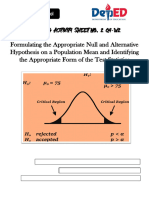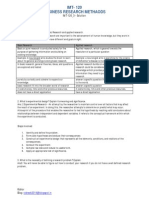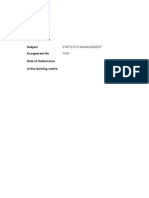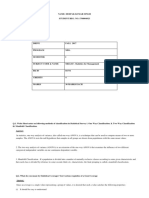MC Math 13 Module 11
MC Math 13 Module 11
Uploaded by
Raffy BarotillaCopyright:
Available Formats
MC Math 13 Module 11
MC Math 13 Module 11
Uploaded by
Raffy BarotillaOriginal Title
Copyright
Available Formats
Share this document
Did you find this document useful?
Is this content inappropriate?
Copyright:
Available Formats
MC Math 13 Module 11
MC Math 13 Module 11
Uploaded by
Raffy BarotillaCopyright:
Available Formats
Module 11
Hypothesis Testing
Prepared by:
EDWARD B. PESCUELA
Instructor
“Most people use statistics like a drunk man uses a lamppost; more for support than
illumination”
― Andrew Lang
MC MATH 13: ELEMENTARY STATISTICS & PROBABILITY |PESCUELA s. 2021
MODULE 11
Hypothesis Testing
Introduction
Hypothesis testing is an act in statistics whereby an analyst tests an assumption regarding a
population parameter. The methodology employed by the analyst depends on the nature of the data used
and the reason for the analysis. Hypothesis testing is used to assess the plausibility of a hypothesis by
using sample data. Such data may come from a larger population, or from a data-generating process. The
word "population" will be used for both of these cases in the following descriptions.
Before each activity, fast facts and discussions are given to help you understand the concepts and
processes involved as well as to solve problems in each activity. The activities will be done individually.
Answers in every assessment must be written or encoded on a short bond paper following the given
format. Please do not forget to write your significant learning experience at the last part of your output. The
submission of Module 11 outputs will be on May 25, 2021. If you have queries, you may reach me through
FB Group Chat during our scheduled date. Thank you and have fun!
Format
Name: ______________________________________ Year & Section: ________________
Date: _______________________________________ Instructor: Mr. Edward B. Pescuela
MC Math 13: Elementary Statistics & Probability
Module 11: Hypothesis Testing
Pretest/Exercise1/Activity 1
1.)
2.)
3.)
My Significant Learning Experience
In this module, I have learned that …
_________________________________________________________________________
_________________________________________________________________________
_________________________________________________________________________
_________________________________________________________________________
_________________________________________________________________________
_________________________________________________________________________
.
_____________________________
Signature over Printed Name
MC MATH 13: ELEMENTARY STATISTICS & PROBABILITY |PESCUELA s. 2021
Objectives
At the end of the week, the pre-service teacher (PST) should be able to:
1. differentiate between null and alternative hypotheses
2. formulate null and alternative hypotheses based on the given problem
3. make statistically-based decisions regarding populations through hypothesis testing
procedure using the traditional method and/or p-value method
(Note: Although the definitions of null and alternative hypotheses given here use the word
parameter, these definitions can be extended to include other terms such as distributions and
randomness. This is explained in later chapters.)
As an illustration of how hypotheses should be stated, three different statistical studies will
be used as examples.
Situation A. A medical researcher is interested in finding out whether a new medication will
have any undesirable side effects. The researcher is particularly concerned with the pulse rate of
the patients who take the medication. Will the pulse rate increase, decrease, or remain unchanged
after a patient takes the medication?
Since the researcher knows that the mean pulse rate for the population under study
is 82 beats per minute, the hypotheses for this situation are
𝐻0 : 𝜇 = 82 𝑎𝑛𝑑 𝐻1 : 𝜇 ≠ 82
The null hypothesis specifies that the mean will remain unchanged, and the alternative
hypothesis states that it will be different. This test is called a two-tailed test (a term that will be
formally defined later in this section), since the possible side effects of the medicine could be to
raise or lower the pulse rate.
MC MATH 13: ELEMENTARY STATISTICS & PROBABILITY |PESCUELA s. 2021
Situation B. A chemist invents an additive to increase the life of an automobile battery. If the
mean lifetime of the automobile battery without the additive is 36 months, then her hypotheses are
𝐻0 : 𝜇 = 36 𝑎𝑛𝑑 𝐻1 : 𝜇 > 36
In this situation, the chemist is interested only in increasing the lifetime of the batteries, so her
alternative hypothesis is that the mean is greater than 36 months. The null hypothesis is that the
mean is equal to 36 months. This test is called right-tailed, since the interest is in an increase only.
Situation C. A contractor wishes to lower heating bills by using a special type of insulation in
houses. If the average of the monthly heating bills is $78, her hypotheses about heating costs with
the use of insulation are
𝐻0 : 𝜇 = $78 𝑎𝑛𝑑 𝐻1 : 𝜇 < $78
This test is a left-tailed test, since the contractor is interested only in lowering heating costs.
To state hypotheses correctly, researchers must translate the conjecture or claim from words into
mathematical symbols. The basic symbols used are as follows:
Equal to = Greater than >
Not equal to ≠ Less than >
The null and alternative hypotheses are stated together, and the null hypothesis contains the
equals sign, as shown (where k represents a specified number).
The formal definitions of the different types of tests are given later in this section.
In this book, the null hypothesis is always stated using the equal’s sign. This is done because
in most professional journals, and when we test the null hypothesis, the assumption is that the mean,
proportion, or standard deviation is equal to a given specific value.
Also, when a researcher conducts a study, he or she is generally looking for evidence to
support a claim. Therefore, the claim should be stated as the alternative hypothesis, i.e., using < or
> or ≠. Because of this, the alternative hypothesis is sometimes called the research hypothesis.
MC MATH 13: ELEMENTARY STATISTICS & PROBABILITY |PESCUELA s. 2021
A claim, though, can be stated as either the null hypothesis or the alternative hypothesis;
however, the statistical evidence can only support the claim if it is the alternative hypothesis.
Statistical evidence can be used to reject the claim if the claim is the null hypothesis. These facts
are important when you are stating the conclusion of a statistical study.
Table 8–1 shows some common phrases that are used in hypotheses and conjectures, and
the corresponding symbols. This table should be helpful in translating verbal conjectures into
mathematical symbols.
MC MATH 13: ELEMENTARY STATISTICS & PROBABILITY |PESCUELA s. 2021
In this type of statistical test, the mean is computed for the data obtained from the sample
and is compared with the population mean. Then a decision is made to reject or not reject the null
hypothesis on the basis of the value obtained from the statistical test. If the difference is significant,
the null hypothesis is rejected. If it is not, then the null hypothesis is not rejected.
In the hypothesis-testing situation, there are four possible outcomes. In reality, the null
hypothesis may or may not be true, and a decision is made to reject or not reject it on the basis of
the data obtained from a sample. The four possible outcomes are shown in Figure 8–2. Notice that
there are two possibilities for a correct decision and two possibilities for an incorrect decision.
If a null hypothesis is true and it is rejected, then a type I error is made. In situation A, for
instance, the medication might not significantly change the pulse rate of all the users in the
population; but it might change the rate, by chance, of the subjects in the sample. In this case, the
researcher will reject the null hypothesis when it is really true, thus committing a type I error.
On the other hand, the medication might not change the pulse rate of the subjects in the
sample, but when it is given to the general population, it might cause a significant increase or
decrease in the pulse rate of users. The researcher, on the basis of the data obtained from the sample,
will not reject the null hypothesis, thus committing a type II error.
In situation B, the additive might not significantly increase the lifetimes of automobile
batteries in the population, but it might increase the lifetimes of the batteries in the sample. In this
case, the null hypothesis would be rejected when it was really true. This would be a type I error.
On the other hand, the additive might not work on the batteries selected for the sample, but if it
were to be used in the general population of batteries, it might significantly increase their lifetimes.
The researcher, on the basis of information obtained from the sample, would not reject the null
hypothesis, thus committing a type II error.
MC MATH 13: ELEMENTARY STATISTICS & PROBABILITY |PESCUELA s. 2021
In a hypothesis-testing situation, the researcher decides what level of significance to use. It
does not have to be the 0.10, 0.05, or 0.01 level. It can be any level, depending on the seriousness
of the type I error. After a significance level is chosen, a critical value is selected from a table for
the appropriate test. If a z test is used, for example, the z table (Table E in Appendix C) is consulted
to find the critical value. The critical value determines the critical and noncritical regions.
The critical value can be on the right side of the mean or on the left side of the mean for a
one-tailed test. Its location depends on the inequality sign of the alternative hypothesis. For
example, in situation B, where the chemist is interested in increasing the average lifetime of
automobile batteries, the alternative hypothesis is 𝐻1 : 𝜇 > 36. Since the inequality sign is >, the
null hypothesis will be rejected only when the sample mean is significantly greater than 36. Hence,
the critical value must be on the right side of the mean. Therefore, this test is called a right-tailed
test.
MC MATH 13: ELEMENTARY STATISTICS & PROBABILITY |PESCUELA s. 2021
To obtain the critical value, the researcher must choose an alpha level. In situation B,
suppose the researcher chose 𝛼 = 0.01. Then the researcher must find a z value such that 1% of the
area falls to the right of the z value and 99% falls to the left of the z value, as shown in Figure 8–
4(a).
Next, the researcher must find the area value in Table E closest to 0.9900. The critical z
value is 2.33, since that value gives the area closest to 0.9900 (that is, 0.9901), as shown in Figure
8–4(b).
The critical and noncritical regions and the critical value are shown in Figure 8–5.
Now, move on to situation C, where the contractor is interested in lowering the heating bills.
The alternative hypothesis is 𝐻1 : 𝜇 < $78. Hence, the critical value falls to the left of the mean.
This test is thus a left-tailed test. At 𝛼 = 0.01, the critical value is -2.33, since 0.0099 is the closest
value to 0.01. This is shown in Figure 8–6.
When a researcher conducts a two-tailed test, as in situation A, the null hypothesis can be
rejected when there is a significant difference in either direction, above or below the mean.
MC MATH 13: ELEMENTARY STATISTICS & PROBABILITY |PESCUELA s. 2021
MC MATH 13: ELEMENTARY STATISTICS & PROBABILITY |PESCUELA s. 2021
Similar procedures are used to find other values of a.
Figure 8–9 with rejection regions shaded shows the critical value (C.V.) for the three
situations discussed in this section for values of 𝛼 = 0.10, 𝛼 = 0.05, and 𝛼 = 0.01. The procedure
for finding critical values is outlined next (where k is a specified number).
MC MATH 13: ELEMENTARY STATISTICS & PROBABILITY |PESCUELA s. 2021
MC MATH 13: ELEMENTARY STATISTICS & PROBABILITY |PESCUELA s. 2021
MC MATH 13: ELEMENTARY STATISTICS & PROBABILITY |PESCUELA s. 2021
In hypothesis testing, the following steps are recommended.
1. State the hypotheses. Be sure to state both the null and the alternative hypotheses.
2. Design the study. This step includes selecting the correct statistical test, choosing a level
of significance, and formulating a plan to carry out the study. The plan should include
information such as the definition of the population, the way the sample will be selected,
and the methods that will be used to collect the data.
3. Conduct the study and collect the data.
4. Evaluate the data. The data should be tabulated in this step, and the statistical test should
be conducted. Finally, decide whether to reject or not reject the null hypothesis.
5. Summarize the results.
For the purposes of this chapter, a simplified version of the hypothesis-testing procedure
will be used, since designing the study and collecting the data will be omitted. The
steps are summarized in the Procedure Table.
MC MATH 13: ELEMENTARY STATISTICS & PROBABILITY |PESCUELA s. 2021
P-Value Method for Hypothesis Testing
Statisticians usually test hypotheses at the common 𝛼 levels of 0.05 or 0.01 and sometimes
at 0.10. Recall that the choice of the level depends on the seriousness of the type I error. Besides
listing an 𝛼 value, many computer statistical packages give a P-value for hypothesis tests.
In other words, the P-value is the actual area under the standard normal distribution curve
(or other curve, depending on what statistical test is being used) representing the probability of a
particular sample statistic or a more extreme sample statistic occurring if the null hypothesis is true.
The P-value method for testing hypotheses differs from the traditional method somewhat.
The steps for the P-value method are summarized next.
MC MATH 13: ELEMENTARY STATISTICS & PROBABILITY |PESCUELA s. 2021
MC MATH 13: ELEMENTARY STATISTICS & PROBABILITY |PESCUELA s. 2021
The following guidelines can be used, but be advised that these guidelines are not written
in stone, and some statisticians may have other opinions.
MC MATH 13: ELEMENTARY STATISTICS & PROBABILITY |PESCUELA s. 2021
Evaluation
Car Thefts
You recently received a job with a company that manufactures an automobile antitheft
device. To conduct an advertising campaign for the product, you need to make a claim about the
number of automobile thefts per year. Since the population of various cities in the United States
varies, you decide to use rates per 10,000 people. (The rates are based on the number of people
living in the cities.) Your boss said that last year the theft rate per 10,000 people was 44 vehicles.
You want to see if it has changed. The following are rates per 10,000 people for 36 randomly
selected locations in the United States.
Using this information, answer these questions. (Use the traditional and p-value approach in
testing your hypothesis)
1. What hypotheses would you use?
2. Is the sample considered small or large?
3. What assumption must be met before the hypothesis test can be conducted?
4. Which probability distribution would you use?
5. Would you select a one- or two-tailed test? Why?
6. What critical value(s) would you use?
7. Conduct a hypothesis test. Use 𝜎 = 30.3.
8. What is your decision?
9. What is your conclusion?
10. Write a brief statement summarizing your conclusion.
11. If you lived in a city whose population was about 50,000, how many automobile thefts per
year would you expect to occur?
Reference
Bluman, Allan G. Elementary Statistics: a step-by-step approach / Allan Bluman. - 8th ed.
MC MATH 13: ELEMENTARY STATISTICS & PROBABILITY |PESCUELA s. 2021
You might also like
- Keri Burnor To International CourtDocument19 pagesKeri Burnor To International CourtGeneration GenerationNo ratings yet
- DBA-5102 Statistics - For - Management AssignmentDocument12 pagesDBA-5102 Statistics - For - Management AssignmentPrasanth K SNo ratings yet
- Final Exam StatisticsDocument2 pagesFinal Exam StatisticsNorthwest Franco0% (1)
- Ken Black QA 5th Chapter 9 SolutionDocument44 pagesKen Black QA 5th Chapter 9 SolutionRushabh Vora50% (2)
- G Power CalculationDocument9 pagesG Power CalculationbernutNo ratings yet
- Test Grafomotor de Pascual para NiñosDocument14 pagesTest Grafomotor de Pascual para NiñosLeonardo HerreraNo ratings yet
- XIV. Hypothesis TestingDocument46 pagesXIV. Hypothesis Testinglorviejohnvfantilagan02No ratings yet
- MC Math 13 Module 12Document12 pagesMC Math 13 Module 12Raffy BarotillaNo ratings yet
- Q4 LAS 2 Stat&Prob W2Document10 pagesQ4 LAS 2 Stat&Prob W2Avelyn BenitezNo ratings yet
- Stating Null Hypothesis in Research PaperDocument7 pagesStating Null Hypothesis in Research Paperalrasexlie1986100% (2)
- G PowerDocument5 pagesG PowerJembia Hassan HussinNo ratings yet
- Biometry NoteDocument89 pagesBiometry NotetofakalidNo ratings yet
- Defining Hypothesis TestingDocument17 pagesDefining Hypothesis TestingRv EstebanNo ratings yet
- HYPOTHESIS TESTING - EditedDocument12 pagesHYPOTHESIS TESTING - EditedsalesNo ratings yet
- Power To The People ManuscriptDocument42 pagesPower To The People ManuscriptZerlinda SanamNo ratings yet
- Educational Statistics: NAME: Muhammad Zeeshan AbbasDocument8 pagesEducational Statistics: NAME: Muhammad Zeeshan AbbasMuhammad zeeshanNo ratings yet
- StatDocument70 pagesStatcj_anero67% (3)
- Sample Size Determination and Power Analysis UsingDocument13 pagesSample Size Determination and Power Analysis UsingAbidNo ratings yet
- Literature Review On Chi Square TestDocument8 pagesLiterature Review On Chi Square Testc5p5qwnw100% (1)
- Module 2.6 PowerAnalysisDocument13 pagesModule 2.6 PowerAnalysisscribd.surname723No ratings yet
- Sample Thesis Using T-TestDocument8 pagesSample Thesis Using T-TestHelpWithYourPaperSingapore100% (2)
- Chapter 8 Hypothesis TestingDocument19 pagesChapter 8 Hypothesis TestingdomingojaynelleNo ratings yet
- Hypothesis Testing - Lecture NotesDocument7 pagesHypothesis Testing - Lecture NotesJane Mariel JayaNo ratings yet
- Stat Q4 Mod 2 Week2newDocument14 pagesStat Q4 Mod 2 Week2newjakeryanumayam1No ratings yet
- 8614 Solved PaperDocument9 pages8614 Solved PaperFatimaNo ratings yet
- 04 Statistical Inference v0 1 09062022 090226pmDocument42 pages04 Statistical Inference v0 1 09062022 090226pmSaif ali KhanNo ratings yet
- Chapter 8: Introduction To Hypothesis TestingDocument6 pagesChapter 8: Introduction To Hypothesis TestingRuru UwuNo ratings yet
- Kang (2021)Document12 pagesKang (2021)Syara Shazanna ZulkifliNo ratings yet
- Solution IMT-120 3Document8 pagesSolution IMT-120 3Kishor kumar BhatiaNo ratings yet
- Name Roll No Learning Centre Subject Assignment No Date of Submission at The Learning CentreDocument11 pagesName Roll No Learning Centre Subject Assignment No Date of Submission at The Learning CentreVikash AgrawalNo ratings yet
- Introduction To Quantitative ResearchDocument17 pagesIntroduction To Quantitative ResearchJheri CoolNo ratings yet
- Weeks 5 10Document19 pagesWeeks 5 10Boys LoveNo ratings yet
- Q 4 Module 3Document16 pagesQ 4 Module 3Arjay AtencioNo ratings yet
- Chapter 3 Hypothesis TestingDocument19 pagesChapter 3 Hypothesis TestingGetaneh YenealemNo ratings yet
- 7 Chance VariationDocument38 pages7 Chance VariationMade NujitaNo ratings yet
- Chapter 8 - One-Way Repeated-Measures ANOVA - 2019Document27 pagesChapter 8 - One-Way Repeated-Measures ANOVA - 2019Ti SINo ratings yet
- RM4151 Class Notes3Document14 pagesRM4151 Class Notes3contactnathan4No ratings yet
- Formulating Causal Questions and Principled Statistical AnswersDocument26 pagesFormulating Causal Questions and Principled Statistical AnswersEnrico RipamontiNo ratings yet
- Stat - Prob-Q4-Module-2Document14 pagesStat - Prob-Q4-Module-2Rowena SoronioNo ratings yet
- Name: Deepak Kumar Singh Student Reg. No. 1708004923Document6 pagesName: Deepak Kumar Singh Student Reg. No. 1708004923Deepak SinghNo ratings yet
- Introduction To Statistics. An Overview of StatisticsDocument11 pagesIntroduction To Statistics. An Overview of StatisticsDana_niaNo ratings yet
- Review Questions StatisitcsDocument8 pagesReview Questions Statisitcss2100016No ratings yet
- Hypothesis Testing Part IDocument8 pagesHypothesis Testing Part IAbi AbeNo ratings yet
- CH 0910Document40 pagesCH 0910darshshri7777No ratings yet
- Final ExamDocument13 pagesFinal ExamILIG, Pauline Joy E.No ratings yet
- Module 1Document5 pagesModule 1Mary Seal Cabrales-Pejo0% (1)
- 05 - One-Sample T TestDocument26 pages05 - One-Sample T TestMady100% (1)
- OLANTIGUE Written ReportDocument15 pagesOLANTIGUE Written ReportJessie OlantigueNo ratings yet
- Week 3 Formulating Hypothesis and VariablesDocument6 pagesWeek 3 Formulating Hypothesis and Variablesjessica ignacioNo ratings yet
- Critical Journal Review: "Hypothesis Test"Document14 pagesCritical Journal Review: "Hypothesis Test"no oneNo ratings yet
- Wolkite University College of Computing and Informatics Department of Information SystemsDocument11 pagesWolkite University College of Computing and Informatics Department of Information SystemsAmanuel KebedeNo ratings yet
- ACFrOgC2 Bbwg3ORnN7gAa-GHcIa7ul2bVBZ6G9XDfVjmI6G4kHrdOq-Oh0 Oi L1dd-Bfv76Jw4bJtEeq1ul V IZPR9z7wOg5SzGzE6yPsbYlA2Y TXkNT8RzK0dTnIskqO5kKRPtlcZNVW0XDocument9 pagesACFrOgC2 Bbwg3ORnN7gAa-GHcIa7ul2bVBZ6G9XDfVjmI6G4kHrdOq-Oh0 Oi L1dd-Bfv76Jw4bJtEeq1ul V IZPR9z7wOg5SzGzE6yPsbYlA2Y TXkNT8RzK0dTnIskqO5kKRPtlcZNVW0Xs2100016No ratings yet
- Unit 8 Sample Surveys: Associated Study Materials 1 SamplingDocument7 pagesUnit 8 Sample Surveys: Associated Study Materials 1 SamplingAbdul RazzakNo ratings yet
- Clinical Prediction Models: A Practical Approach to Development, Validation, and UpdatingFrom EverandClinical Prediction Models: A Practical Approach to Development, Validation, and UpdatingNo ratings yet
- MCC301Document7 pagesMCC301Pawan PratikNo ratings yet
- PSYC 6213 Unit2Document6 pagesPSYC 6213 Unit2hibasaleemmNo ratings yet
- Data and the American Dream: Contemporary Social Controversies and the American Community SurveyFrom EverandData and the American Dream: Contemporary Social Controversies and the American Community SurveyRating: 1 out of 5 stars1/5 (1)
- The Demand for Life Insurance: Dynamic Ecological Systemic Theory Using Machine Learning TechniquesFrom EverandThe Demand for Life Insurance: Dynamic Ecological Systemic Theory Using Machine Learning TechniquesNo ratings yet
- Success Probability Estimation with Applications to Clinical TrialsFrom EverandSuccess Probability Estimation with Applications to Clinical TrialsNo ratings yet
- Applied Statistics Manual: A Guide to Improving and Sustaining Quality with MinitabFrom EverandApplied Statistics Manual: A Guide to Improving and Sustaining Quality with MinitabNo ratings yet
- MC Math 13 Module 14Document10 pagesMC Math 13 Module 14Raffy BarotillaNo ratings yet
- MC Math 13 Module 10Document15 pagesMC Math 13 Module 10Raffy BarotillaNo ratings yet
- MC Math 13 Module 9Document17 pagesMC Math 13 Module 9Raffy BarotillaNo ratings yet
- MC Math 13 Module 2Document13 pagesMC Math 13 Module 2Raffy BarotillaNo ratings yet
- MC Math 13 Module 3Document16 pagesMC Math 13 Module 3Raffy BarotillaNo ratings yet
- Action Research FinalDocument41 pagesAction Research FinalRaffy BarotillaNo ratings yet
- MC Math 13 Module 1Document26 pagesMC Math 13 Module 1Raffy BarotillaNo ratings yet
- MC Math 18 Module 7-8Document13 pagesMC Math 18 Module 7-8Raffy BarotillaNo ratings yet
- MC Math 18 Module 5-6Document11 pagesMC Math 18 Module 5-6Raffy BarotillaNo ratings yet
- SWOT AnalysisDocument2 pagesSWOT AnalysisDeepak Pai BNo ratings yet
- Lesson I Learning To Be A Better LearnerDocument4 pagesLesson I Learning To Be A Better LearnergheillyiaceNo ratings yet
- Stem Cell Research EssayDocument7 pagesStem Cell Research Essayapi-286667026No ratings yet
- (Rapport Reviwer 1) Review CommentsDocument3 pages(Rapport Reviwer 1) Review Commentstaoufik akabliNo ratings yet
- Reva ThyDocument182 pagesReva ThyJulia StantonNo ratings yet
- A Century of Telemedicine: Curatio Sine Distantia Et Tempora A World Wide Overview - Part IDocument321 pagesA Century of Telemedicine: Curatio Sine Distantia Et Tempora A World Wide Overview - Part IAnton VladzymyrskyyNo ratings yet
- George W. Stocking Jr. Objects and Others. Essays On Museums and Material CultureDocument268 pagesGeorge W. Stocking Jr. Objects and Others. Essays On Museums and Material CultureAndrea Aliaga MNo ratings yet
- P222 - Final Presentation (PDF) (Reynaldo)Document15 pagesP222 - Final Presentation (PDF) (Reynaldo)Shamah ReynaldoNo ratings yet
- Factors Associated With The Adoption and Use of Management Accounting Techniques in Developing Countries: The Case of RomaniaDocument32 pagesFactors Associated With The Adoption and Use of Management Accounting Techniques in Developing Countries: The Case of RomaniaBogdanNo ratings yet
- Project Manager CV Example 7 PDFDocument2 pagesProject Manager CV Example 7 PDFKhalid Wazir100% (1)
- Journal Article Critique of Classroom Management StudiesDocument5 pagesJournal Article Critique of Classroom Management StudiesAmy SpencerNo ratings yet
- Syed - BSBLED802 - TASK 1Document8 pagesSyed - BSBLED802 - TASK 1santosh budhathoki100% (2)
- Solve Statistics Homework AnswersDocument7 pagesSolve Statistics Homework Answersafnahsypzmbuhq100% (1)
- 1998 Stereotypes About Attractiveness - When Beautiful Is Not BetterDocument15 pages1998 Stereotypes About Attractiveness - When Beautiful Is Not BetterDHWANI MODINo ratings yet
- Mystery ShoppingDocument24 pagesMystery ShoppingrikabothraNo ratings yet
- Disaster Risk Reduction Management of University of Rizal System: Perspectives For Strategic ActionDocument12 pagesDisaster Risk Reduction Management of University of Rizal System: Perspectives For Strategic ActionLee Hock SengNo ratings yet
- CII AWARD PresentationDocument14 pagesCII AWARD Presentationsekarchand33No ratings yet
- DSJKH LAHdiDocument43 pagesDSJKH LAHdiJennifer RomuloNo ratings yet
- John Locke EssaysDocument5 pagesJohn Locke Essaysafabkkkrb100% (2)
- Practical Applications of The Punched Card Method in Colleges and Universities PDFDocument478 pagesPractical Applications of The Punched Card Method in Colleges and Universities PDFCharles Michael ProvinceNo ratings yet
- Religious Rituals in Tayabas Quezon Phil PDFDocument74 pagesReligious Rituals in Tayabas Quezon Phil PDFChristopher YsitNo ratings yet
- CJR InggrisDocument11 pagesCJR InggrisRizky Bayu AnandaNo ratings yet
- JCST SCALE-UP Article PDFDocument6 pagesJCST SCALE-UP Article PDFHelder PradoNo ratings yet
- SynopsisDocument3 pagesSynopsisbhagyasreesukumaran47No ratings yet
- Quality ControlDocument21 pagesQuality ControlInbalidNo ratings yet
- Action Research Proposal - ZNHSDocument15 pagesAction Research Proposal - ZNHSJOHN PONCE GALMANNo ratings yet
- Business Model AssignmentDocument5 pagesBusiness Model AssignmentVictor DeleclozNo ratings yet
- Termguard Technical Manual 2019 Edition 13Document95 pagesTermguard Technical Manual 2019 Edition 13ReggiebertSintosNo ratings yet


































































































